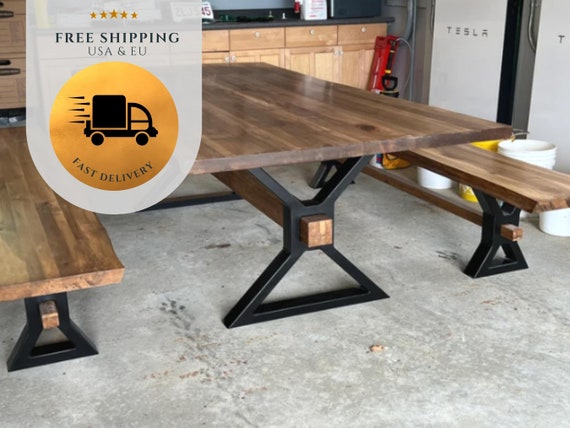Find the Ideal Dining Room Table Legs for Any Interior Design Style
Expert Tips for Putting Up Eating Area Table Legs for Maximum Security
When it comes to mounting dining space table legs, accomplishing maximum stability is vital for both capability and looks. The process begins with choosing the best products and hardware, followed by careful alignment and consideration of weight circulation. Each step plays a critical duty in making sure that the ended up product holds up against daily use without compromising safety or layout integrity. However, recognizing the nuances of these aspects can significantly affect the overall outcome. What particular methods can enhance stability even additionally?
Pick the Right Legs
When selecting the ideal legs for your dining-room table, it is important to consider both performance and visual appeals. The legs you select will dramatically influence the total design and stability of the table. Evaluate the table's meant usage; if you anticipate constant celebrations, sturdier legs, such as those made from strong wood or metal, may be extra ideal, as they use increased toughness and support.
Following, think about the height and style of the legs in regard to the tabletop. Conventional dining tables normally vary from 28 to 30 inches in elevation, so guarantee the legs straighten with this criterion for comfort. The style of the legs ought to complement the design of the table top-- whether it be modern-day, rustic, or standard. For example, tapered legs can add a contemporary touch, while transformed legs may convey an extra timeless visual.

Select Appropriate Equipment
How can the best hardware improve the security and durability of your eating area table? The choice of suitable equipment is critical to guaranteeing that the legs of your table are securely attached and able to withstand regular usage. High-grade screws, screws, and braces supply the essential strength to sustain the weight of the table, in addition to any kind of additional loads placed upon it throughout events or meals.
When picking screws, decide for those made from durable materials such as stainless-steel or brass, which stand up to corrosion and maintain honesty in time. The size of the screws is similarly vital; they ought to penetrate deeply into the table's structure without jeopardizing stability. For bolted connections, consider making use of lock washing machines to avoid loosening up because of vibration or activity.
In addition, utilizing corner brackets can add additional support, particularly for larger tables or those with much heavier tops. These braces distribute weight uniformly and aid maintain the table's form. Making certain that the equipment you choose is ideal for the details materials of your table useful site will further enhance its total stability and longevity, allowing you to appreciate your dining experience for years to find.
Ensure Appropriate Placement
Proper positioning of eating room table legs is crucial for both aesthetic allure and functional security. To attain optimal positioning, begin by determining the range from the table's corners to the leg accessory factors.
Utilize a level throughout setup to validate that each leg is perpendicular to the tabletop. It is a good idea to mark the wanted leg placements on the underside of the table with a pencil or covering up tape before protecting them.
In addition, double-check the positioning after the preliminary screws are tightened up, as adjustments may be required before totally securing the equipment. By prioritizing appropriate positioning, you not just enhance the table's total design however likewise make certain that it stays practical and steady for many years ahead.

Consider Weight Circulation
After guaranteeing proper placement of the eating room table legs, it is very important to take into consideration weight distribution to enhance security and capability. dining room table legs. Correct weight circulation is critical in preventing ensuring and tottering that the table can sustain its designated tons without danger of tipping or collapsing
When placing the legs, ensure they are positioned at equivalent distances from the center of the table to equally distribute the weight across the structure. Think about the weight of the table top and any kind of things that will regularly relax on it, such as attractive pieces or tabletop appliances. Tables with larger surface areas should preferably have legs positioned closer to the edges, as this optimizes the base of support and decreases the risk of instability.
In addition, if the table is planned for usage in a high-traffic area, take into consideration utilizing much heavier materials for the legs or including stabilizing aspects, such as cross-bracing or a lower shelf - dining room table legs. These modifications can aid maintain balance and stop shifting during usage. Ultimately, a well-considered weight other distribution approach will significantly improve the table's general efficiency, guaranteeing it remains a appealing and practical focal point for your eating room
Examination Stability Before Usage
Checking the security of the dining space table prior to use is an important step that ought to not be ignored. If the table shows instability, identify the legs or joints that may call for change.
Next, inspect that all screws and bolts are tightened up correctly. Loose connections can lead to instability and potential damage gradually. If necessary, use wood glue on joints to enhance security, making certain to permit ample drying out time.

Conclusion
In verdict, the installation of dining-room table legs calls for careful consideration of materials, positioning, weight, and equipment circulation to attain maximum stability. By picking top notch bolts and durable legs, ensuring accurate positioning, and dispersing weight equally, the structural honesty of the table can be substantially boosted. Conducting a stability test before normal usage additionally ensures that the table will endure daily pressures, thus offering a risk-free and reliable dining experience.
When it comes to installing eating room table legs, achieving maximum stability is critical for both functionality and appearances. The legs you select will substantially influence the general style and stability of the table (dining room table legs). Common eating tables normally range from 28 to 30 inches in height, so make certain the legs straighten with this standard for convenience.Correct positioning of dining space table legs is vital for both visual allure and practical security.In verdict, the installation of dining space table legs requires mindful consideration of materials, weight, alignment, and equipment circulation to attain maximum security